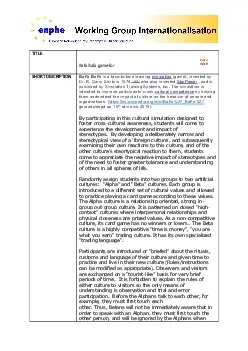

TITLESHORT DESCRIPTIONBaF BaFis a facetosimulationgame invented by Dr R Garry Shirts in 1974123who also inventedStarPower and is published by Simulation Training Systems Inc The simulation is intend ID: 866139
Download Pdf The PPT/PDF document "Bafa Bafa game for" is the property of its rightful owner. Permission is granted to download and print the materials on this web site for personal, non-commercial use only, and to display it on your personal computer provided you do not modify the materials and that you retain all copyright notices contained in the materials. By downloading content from our website, you accept the terms of this agreement.
1 TITLE Bafa Bafa game for
TITLE Bafa Bafa game for SHORT DESCRIPTION BaFá BaFá is a face - to - simulation (game), invented by Dr. R. Garry Shirts in 1974, [1][2][3]who also inventedStarPower , and is published by Simulation Training Systems, Inc. The simulation is intended to improve participants' cross by helping them understand the impact of culture on the behavior of people and organizations. https://en.wikipedia.org/wiki/BaFa%27_BaFa%27 geraadpleegd op 15of march 2019) By participating in this cultural simulation designed to foster crosscultural awareness, students will come to stereotypes.By developing a deliberately narrow and stereotypical view of a ‘foreign culture’, and subsequently examining their own reactions to this culture, and of the other culture’ssteortypicalreaction to them, students come to appreciate the negative impact of stereotypes and of the need to foster greater tolerance and understanding of others in all spheres of life. Randomly assign students into two groups to two artificial cultures:“Alpha” and “Beta” cultures. Each group is introduced to a different set of cultural values and allowed to practice playing a card game according to these values. The Alpha culture is a relationship oriented, strong in group outgroup culture. It is patterned on closed "high context" cultures where interpersonal relationships and culture, its card game has no winners or losers.The Beta culture is a highly competitive "time is money", "you are what you earn" trading culture. It has its own specialized "trading language". Participants are introduced or “briefed” about the rituals, customs and language of their culture and given time to can be modified as appropriate). Observers and visitors are exchanged on a
2 “touristlike” basis for very
“touristlike” basis for very brief periods of time.It is forbidden to explain the rules of either culture to visitors so the only means of understanding is observation and trial and error participation.Before theAlphanslk to each other, for example, they must first touch each other.Thus,Betanswill not be immediately aware that in order to speak with anAlphan, they must first touch the other person, and will be ignored by the Alphans when they try to speak to them. S anctions are imposed when cultural norms are violated.After repeated attempts by Betansto talk to theAlphans, theAlphanswill offer Betanvisitor a card, which lets otherAlphansknow that the visitor has been sanctioned. GOALS (why do we use it?) (1)To help students come to understand the meaning and impact of culture(2)To demonstrate how one’s feelings of attachment to a given culture are learned though the processes of socialization, and that one’s tendency to judge other cultures is based on one’s own cultural perspective.(3)To demonstrate the potential for misinterpretation that arises when one evaluates another culture solely from the perspective of one’s own values(4)To build awareness of the extent to whichcultures can vary (cultural difference) and to help students work through these differences (5)To help students to come to appreciate cultural diversity and to examine their attitudes and behaviors towards others who are ‘different’ than themselves. TARGET GROUP (students, staff, international classrooms, bachelor or master students …) Anyone who wants to become more sensitive about intercultural interaction PIECE OF THE JONES MODEL Part 3 Intracurriculair Theme: cultural awareness INSTITUTION or SOURCE https://en.wikipedia.org/wiki/BaFa%27_BaFa%27 CONTA CT PERSON or internet - link